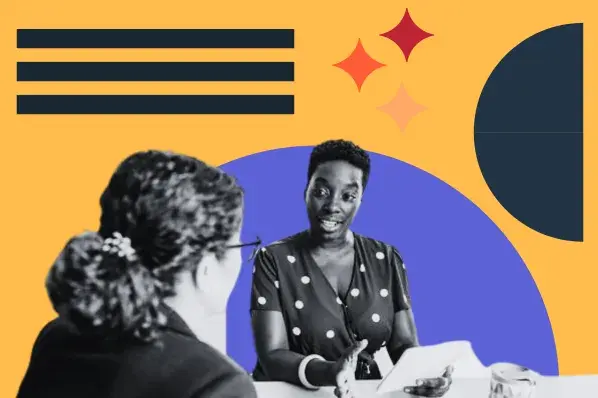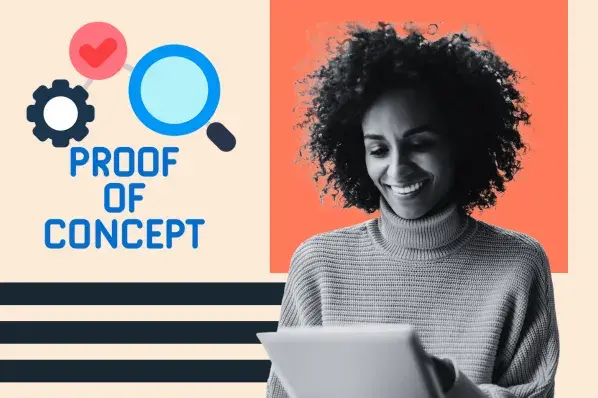But every time I got on a call and tried to steer the conversation without a real plan, I felt like I was flailing. I knew my work was solid, but I didn’t have a reliable way to guide the conversation, ask the right questions, or qualify leads without feeling awkward.
Eventually, I found structure in the Sandler Selling System.
It helped me stop guessing and start approaching sales as a collaborative conversation. In this piece, I’ll break down what Sandler is, why it works (especially if you’re not a “salesy” person), and how to start using it, one step at a time.
Table of Contents
- What is the Sandler Selling System?
- Steps of the Sandler Selling System
- How to Incorporate the Sandler Selling System
The Sandler Sales Submarine
One of the best ways to understand the system is through its “submarine” analogy. David Sandler, who developed the framework, took inspiration from WWII films. In a submarine under attack, the crew would move through each compartment, sealing the one behind them to prevent flooding. Sandler applied the same thinking to sales: move through each stage in order, and don’t leave a step unfinished.

Ioanna Mantzouridou Onasi, CEO of the AI sales coaching firm Dextego, puts it this way: “It helps me make sure I don’t skip critical steps — especially in more complex deals. Each stage has to be locked in before I move on, which makes the whole process more manageable.”
That clarity and structure are what make Sandler so useful. Let’s walk through how each step works.
Biggest Perks of the Sandler Process
While the Sandler Selling System shares some similarities with traditional sales methodologies, its focus on qualification — not closing — is what sets it apart. This emphasis ensures sales teams prioritize fit over force, leading to stronger long-term outcomes.
According to HubSpot’s 2024 State of Sales Report, 58% of reps say landing “best-fit deals” is among their most effective selling techniques. Emma Brudner, former marketing director at HubSpot, explains why:
“If the rep discovers that their offering won‘t truly address the potential client’s concerns, they won‘t waste time convincing them that it actually does — they’ll simply abandon the process. Rather than the seller convincing the buyer to buy, the buyer almost convinces the seller to sell.”
When implemented well, the Sandler process also improves financial performance. In that same report, nearly 1,500 sales reps reported that 47% of their deals ranged between $1,000 and $5,000. If you’re looking to increase your average sales price (ASP), Sandler’s qualification-first sales methodology can help you move upmarket.
Beyond deal size, Sandler also helps organizations:
- Improve pipeline accuracy through rigorous qualification
- Shorten sales cycles by eliminating poor-fit opportunities early
- Strengthen forecasting through consistent process adherence
Rebecca Schmidt, former VP of Sandler’s Sales Technology Practice, credits the system’s lasting impact to its roots in behavioral psychology:
“Sandler techniques are fully grounded in a real psychological discipline that focuses on how people truly communicate. They take root when leadership is committed to improving team performance — and leads by example.”
She adds,
“When leadership is energized about the process, we know the team will see results. These leaders use Sandler to build a culture of continuous improvement across sales, pre-sales, and customer success.”
Ready to see how each stage works in practice? Let’s break down the Sandler Selling System step by step.
1. Bonding and Building Rapport
The first step in the Sandler Selling System is building rapport and laying the groundwork for open and honest communication. Rather than being personable, create the psychological safety so prospects feel comfortable discussing budget constraints, internal roadblocks, or gaps in their current strategy.
In HubSpot’s State of Sales report, 26% of sales reps said that building trust and rapport has become even more critical in 2023 than it was in 2022. For high-consideration or complex B2B sales, that trust moves conversations forward.
Early in my freelancing career, I underestimated this step. I once opened a discovery call by jumping straight into a scoping question, only to find the conversation felt cold and transactional. That deal didn’t move forward.
Now, I take time to connect before we talk tactics. Recently, I noticed a prospect had spoken at an AI marketing event. I brought it up at the start of our call, and we ended up having a 15-minute conversation about industry shifts and automation.
The rest of the conversation flowed naturally, and the prospect opened up about issues like misaligned goals, content gaps, and past campaigns that underperformed.
This way, rapport builds a strategic foundation. When you approach it with genuine curiosity, you earn the right to ask better questions later in the process.
2. Upfront Contracts
The second step is setting roles and expectations. This is where I outline how the conversation will go, what we'll cover, and what outcomes we’re aiming for. It creates clarity and helps both sides feel comfortable.
Early in my career, I skipped this step, worried it would sound overly formal. But without clear direction, calls would meander, and I’d end up in awkward territory, unsure how to steer the conversation forward.
Now, I open every sales conversation with a simple upfront contract:
“Before we begin, I’d like to set some expectations. I’m going to ask detailed questions about your content challenges. Some might feel direct, but I want to understand your situation fully before we discuss whether it makes sense to work together. Sound good?”
It’s a small shift, but it immediately frames the discussion as collaborative and purposeful and sets the tone for more focused, productive calls.
3. Pain
Next comes the qualification stage. Now that I've built rapport and set expectations, it’s time to understand what’s driving the prospect’s interest — the pain points that my solution can address.
This stage was one of my biggest struggles. I didn’t want to come across as intrusive. But as Rebecca Schmidt, former VP at Sandler, explained, this discomfort is common.
“Sales reps often struggle with moving beyond the prospect’s first-level pain because it can be uncomfortable to ask second-level pain questions (e.g., How have you tried to solve this? or What has it cost you?) and third-level pain questions (e.g., How is this affecting you personally or professionally?).”
Over time, I’ve realized that third-level pain is often where the buying motivation lives. A marketing director might say their blog content isn’t converting, but a closer look shows they’re working overtime to create content solo, missing family time, and feeling pressure from leadership about ROI. Those personal stakes are what actually prompt change.
Schmidt offered a helpful mental reframe: if asking tough questions feels uncomfortable, try replacing the belief that you’re being intrusive with one that supports your purpose like “I ask these questions because I care about solving the right problem, not just closing the deal.”
To reinforce that belief, I began documenting two things after every call: the specific pain points that surfaced and the business impact tied to each one. For example, if a prospect said their blog isn't converting, I’d note the downstream effects, like poor MQL quality or friction in handoffs to sales.
This forces me to tie every proposal recommendation directly to a business priority.
4. Budget
A traditional sales conversation typically includes budget talk toward the end of the process, but in the Sandler Selling System, you discuss your prospect's budget during the qualification phase.
I know it sounds uncomfortable to talk money upfront, but it has proved worth it. After all, if my prospect can‘t afford my service, there’s no point trying to sell it to them. Keep in mind that 70% of the reps we surveyed felt budgets were more scrutinized in 2023 than they were in 2022, so going over the cost specifics is a must.
I used to dance around budget conversations until the very end, which led to countless wasted hours on proposals for prospects who couldn't afford my rates. Now I address it directly after uncovering their pain:
“Based on what you've shared about your content challenges, solving this properly typically requires an investment between $X and $Y. Is that something you've budgeted for?”
Position budget as a qualification tool and how you’re determining if you're a match. This approach has saved me from pursuing projects that were never going to close and helped me focus on prospects who are serious about solving their problems.
5. Decision
By the time I reach this step, I already know a lot about the prospect’s challenges, priorities, and budget. But things can still fall apart if I’m not clear about how decisions get made.
So ask who the decision-maker is and how decisions happen inside their company.
I’ll say something like:
“Can you walk me through what the internal process looks like if we were to move forward — who’s involved, what kind of approvals are needed, and what timelines are typical?”
Early on, I made the mistake of assuming that the person I was speaking to had final say. More than once, I spent hours creating a proposal that went nowhere because someone else — someone I hadn’t even met — had the real authority.
Now, I get everyone to the table early, or I pause the process until I can. And I don’t tiptoe around this. I’ve found most buyers appreciate the transparency. They don’t want to waste time either.
I also use this stage to clarify smaller, often overlooked details:
- What are they evaluating me against?
- What does success look like from their end?
- What would stop them from moving forward even if everything else checks out?
This step can feel tedious, but it saves you from ghosting and vague “let me check with the team” replies later.
And here’s a stat that aligns with my experience: 23% of sales reps said selling directly to the most senior decision-maker is one of their most effective strategies. I’d push that even further, don’t just sell to them, involve them. Early.
6. Fulfillment
Fulfillment is where I formally propose our solution, aligning it with everything we learned during qualification: their pain, budget, and decision criteria.
Use everything you've learned during the qualifying process.
We‘ve found the average close rate hovers around 29%, so while it might seem impossible at times, I’ve done most of the work by this point, and my odds are looking good.
The beauty of Sandler is that by this stage, I‘m not really "selling" anymore — I’m confirming what we've already established. My proposals now reference specific pain points they shared:
“You mentioned working late nights because your current content process is inefficient. Here's exactly how our strategy will give you back those evening hours.”
I anchor every proposal around the three pillars we've already discussed:
- Pain: What we’re solving, and why it matters.
- Budget: How the investment aligns with the expected impact.
- Decision process: Who’s involved and what needs to happen next?
When a prospect says yes, it feels inevitable rather than surprising because we've been building toward this conclusion throughout our entire conversation.
7. Post-sell
The post-sell stage is where you solidify the relationship, prevent buyer’s remorse, and lay the groundwork for a smooth engagement.
This used to be a gap in my process. I’d celebrate the signed agreement but leave clients in silence until kickoff. That silence often bred uncertainty. Now, as soon as a contract is signed, I send a structured welcome email outlining what happens next, who their points of contact are, and any materials they should prepare.
Within 48 hours, I schedule a brief alignment call to review timelines, communication norms, and the agreed-upon outcomes from the sales process. This ensures we’re starting on solid footing and helps preempt scope drift.
Most importantly, I address post-purchase concerns directly. A simple prompt like:
“It’s normal to have questions after signing — what’s on your mind now?” spots lingering hesitations and reinforces trust before they snowball into issues.
In my experience, a strong post-sale handoff is one of the most overlooked yet valuable aspects of the sales process.
Example Questions for Each Stage of Sandler Selling
Here are a few example questions you can try for each of the seven stages.
| stage | example questions |
|
Bonding and Rapport |
|
|
Upfront Contracts |
|
|
Pain |
|
|
Budget |
|
|
Decision |
|
|
Fulfillment |
|
|
Post-Sell |
|
Asking better questions helped me stop guessing what prospects needed and start understanding what was actually holding them back.
How to Incorporate the Sandler Selling System
I find it challenging to implement any new training into my existing processes, but certain techniques make it easier.
The biggest mistake I made when first learning Sandler was trying to implement all seven steps at once. It felt overwhelming and unnatural. Instead, I now recommend starting with just one or two stages and mastering them before moving on.
I began with upfront contracts because they were the easiest for me to practice. Once that felt natural, I added the pain qualification questions. Within three months, I was using the entire system without thinking about it.
Here's my step-by-step approach for incorporating Sandler into your existing sales process:
- Start with your next three sales calls. Pick one Sandler technique to focus on — I recommend upfront contracts. Use the same opening on all three calls and see how prospects respond.
- Track what works. I keep a simple note in my CRM about which questions got the best responses. After a month, you'll see clear patterns.
- Role-play the uncomfortable parts. Pain questions still feel awkward sometimes. I practice them out loud or even in the mirror before important calls.
- Adapt the language to your business. The Sandler framework is solid, but you need to make the questions sound like you. My budget conversations sound different from a software salesperson's.
Sandler Training Courses
When you’re ready to get started, you can take Sandler sales certification courses online. I really like all the different formats the company offers: I can listen to podcasts on my way to work or read an article during my lunch break. There are even in-person courses.
Next, let's look at the insider tips I got from Schmidt on implementing the Sandler system effectively and getting the most out of it.
Sandler Pro Tips from the Former VP
Schmidt says organizations that are successful with the Sandler Selling System first look at their existing sales process and "work to identify which pieces of Sandler fit within each sales stage and which pieces can be used throughout, making it easy for the rep and managers to see how Sandler helps them execute more effectively .”
Let’s say I’m trying to incorporate Sandler’s upfront philosophy into every sales stage. I might start by requiring my sales leaders to ask their reps, “What does your upfront contract sound like for your next call?”
For individual stages like the Pain Funnel, I can reinforce some of the same questions in other stages. For example, during the discovery or qualifying stages, my boss might say to me, “You asked the prospect how much they lost by not fixing the issue. How did they respond?”
These questions are both open and closed-ended, so you’ll have some easy answers (e.g., it cost them $25,000 per year) and some that are harder to quantify (e.g., they suspect it might have lost them an employee or two).
Each organization‘s sales process looks different, so I recommend doing trials until you find what works best for your unique team’s collaborative style.
To properly teach the Sandler system, it's vital to master it first. As Schmidt tells me, “The biggest roadblock managers and leaders face is trying to reinforce concepts they do not fully understand themselves.”
To prevent this from happening in her workforce, "the managers are always present (and actively engaged) in our rep training. We have separate manager-focused sessions teaching them how to reinforce Sandler throughout their sales process,” she adds.
We all know that change isn't easy, but the more my leadership incorporates the Sandler Selling System into existing processes, the easier it is for reps to get on board. For a more in-depth look at accomplishing this, take a look at this video:
Getting the Most from the Sandler System
The Sandler Selling System isn’t the only sales model out there, but it’s one of the most effective for qualifying prospects and focusing on real-fit opportunities.
At HubSpot, applying Sandler helped us increase our average selling price by 12% and shorten our sales cycle by 18%. That’s because the system emphasizes clarity, structure, and trust, values both Sandler and HubSpot share.
If you want to improve your sales conversations and close better-fit deals, integrating Sandler into your process is a smart place to start.
Editor's note: This post was originally published in October 2021 and has been updated for comprehensiveness.
Sales Methodology

-1.webp)




![I Learned How Sales Champions Drive Deals Forward — Here’s What You Should Know [+ Recent Data]](https://53.fs1.hubspotusercontent-na1.net/hubfs/53/sales-champion-1-20250110-9355712-1.webp)
![Decoding Buying Signals in Sales [+ Examples & What I Learned]](https://53.fs1.hubspotusercontent-na1.net/hubfs/53/buying-signals-1-20250501-3647992.webp)



-3.webp)
